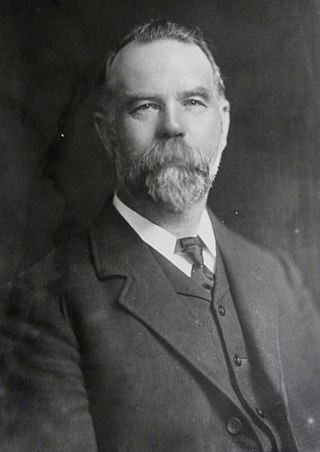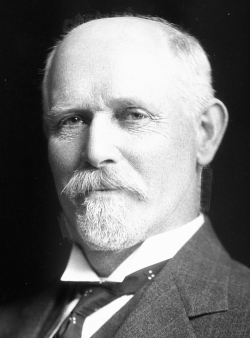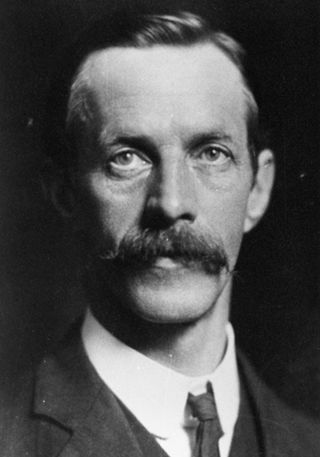
Sir John Pearce Luke was a New Zealand politician. Luke was Mayor of Wellington from 1913 to 1921 and Member of Parliament for Wellington Suburbs 1908–1911 and Wellington North 1918–1928. His brother Charles Manley Luke had previously also been Mayor of Wellington in 1895. Sir John Pearce was nicknamed Peanut because he was short.

Sir William Appleton was a New Zealand local body politician, advertising agent and leading company director. He was Mayor of Wellington for two terms from 1944 to 1950 after serving as a city councillor from 1931 to 1944. He was knighted in 1950.

Robert Alexander Wright was the Mayor of Wellington from 1921 to 1925, and a New Zealand politician of the Reform Party.

The 1901 Wellington City mayoral election was part of the New Zealand local elections held that same year. In 1901, elections were held for the Mayor of Wellington plus other local government positions including twelve city councillors. John Aitken, the incumbent Mayor, was re-elected to office as Mayor of Wellington, beating Thomas Wilford. The polling was conducted using the standard first-past-the-post electoral method.

The 1909 Wellington City mayoral election was part of the New Zealand local elections held that same year. In 1909, elections were held for the Mayor of Wellington plus other local government positions including fifteen city councillors. The polling was conducted using the standard first-past-the-post electoral method.

The 1875 Wellington City mayoral election was the second election for the Mayor of Wellington held by public vote. The election was won by William Hutchison, who beat William Gisborne.

The 1929 Wellington City mayoral election was part of the New Zealand local elections held that same year. In 1929, elections were held for the Mayor of Wellington plus other local government positions including fifteen councillors. The polling was conducted using the standard first-past-the-post electoral method.
This is a summary of the electoral history of Peter Fraser, Prime Minister of New Zealand (1940–49), Leader of the Labour Party (1940–50) and Member of Parliament for Wellington Central (1918–46) then Brooklyn (1946–50).

The 1912 Wellington City mayoral election was part of the New Zealand local elections held that same year. In 1911, elections were held for the Mayor of Wellington plus other local government positions. Thomas Wilford, the incumbent Mayor, resigned due to ill health and did not contest the ensuing election. David McLaren was elected to office as the new Mayor of Wellington, beating three other contenders and becoming the city's first Labour Mayor. The polling was conducted using the standard first-past-the-post electoral method.

The 1917 Wellington City mayoral election was part of the New Zealand local elections held that same year. In 1917, elections were held for the Mayor of Wellington plus other local government positions including fifteen city councillors, also elected biannually. The polling was conducted using the standard first-past-the-post electoral method.
The 1919 Wellington City mayoral election was part of the New Zealand local elections held that same year. In 1919, elections were held for the Mayor of Wellington plus other local government positions including fifteen city councillors. The incumbent Mayor John Luke retained office for a fourth consecutive term. The polling was conducted using the standard first-past-the-post electoral method.
The 1921 Wellington City mayoral election was part of the New Zealand local elections held that same year. In 1921, elections were held for the Mayor of Wellington plus other local government positions including fifteen city councillors. The polling was conducted using the standard first-past-the-post electoral method.

The 1925 Wellington City mayoral election was part of the New Zealand local elections held that same year. In 1925, elections were held for the Mayor of Wellington plus other local government positions including fifteen councillors. The polling was conducted using the standard first-past-the-post electoral method.

The 1931 Wellington City mayoral election was part of the New Zealand local elections held that same year. In 1931, elections were held for the Mayor of Wellington plus other local government positions including fifteen city councillors. The polling was conducted using the standard first-past-the-post electoral method.

The 1933 Wellington City mayoral election was part of the New Zealand local elections held that same year. In 1933, elections were held for the Mayor of Wellington plus other local government positions including the fifteen city councillors, also elected biannually. Thomas Hislop, the incumbent Mayor sought re-election and retained office unopposed with no other candidates emerging. The polling was conducted using the standard first-past-the-post electoral method.

The 1935 Wellington City mayoral election was part of the New Zealand local elections held that same year. In 1935, elections were held for the Mayor of Wellington plus other local government positions including fifteen city councillors. The polling was conducted using the standard first-past-the-post electoral method.

The 1938 Wellington City mayoral election was part of the New Zealand local elections held that same year. In 1938, elections were held for the Mayor of Wellington plus other local government positions including fifteen city councillors. The polling was conducted using the standard first-past-the-post electoral method.

The 1941 Wellington City mayoral election was part of the New Zealand local elections held that same year. In 1941, elections were held for the Mayor of Wellington and fifteen city councillors plus seats on the Wellington Hospital Board and Wellington Harbour Board. The polling was conducted using the standard first-past-the-post electoral method.

The 1944 Wellington City mayoral election was part of the New Zealand local elections held that same year. In 1944, election were held for the Mayor of Wellington plus other local government positions including fifteen city councillors. The polling was conducted using the standard first-past-the-post electoral method.












